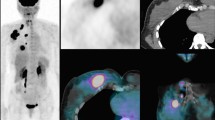Abstract
Background
Guidelines of the American Society of Clinical Oncology (ASCO), the National Comprehensive Cancer Network (NCCN), and the European Society for Medical Oncology (ESMO) discourage the use of imaging to stage newly diagnosed early breast cancer (stages 1 and 2). This study aimed to evaluate preoperative staging imaging rates among patients with stage 1 or 2 breast cancer treated with neoadjuvant chemotherapy (NAC).
Methods
From a prospectively maintained database, 303 patients with stage 1 or 2 breast cancer who had NAC from 2008 to 2016 were identified. The main outcome measures were the rate and outcomes of staging imaging performed.
Results
The mean age of the 303 patients with stage 1 or 2 breast cancer was 51 years (range, 26–87 years). Of these 303 patients, 278 (92.4%) had invasive ductal cancer. 90 (30.2%) had estrogen receptor (ER)-positive disease, 79 (26.5%) had triple-negative disease, and 127 (42.6%) had human epidermal growth factor receptor 2 (HER2)-positive disease. Staging positron emission tomography (PET) or computed tomography (CT) scan was performed for 258 patients (85.2%), brain imaging for 94 patients (31%), bone scans for 117 patients (38.6%), and all three for 48 patients (15.8%). As a result, 15 patients (4.9%) with a positive PET/CT scan were upstaged to stage 4 breast cancer. No difference was observed among the ER-positive (p = 1.000), HER2-positive (p = 0.259), or triple-negative (p = 0.369) receptor profiles of the patients upstaged to stage 4 disease. One patient (1.1%) had positive brain imaging. Five patients (4.3%) had a positive bone scan, and three of these patients (60%) had bone metastasis also shown on the PET/CT scan.
Conclusion
Despite guideline recommendations, a high rate of preoperative staging imaging is completed for patients with clinical stage 1 or 2 breast cancer who receive NAC, with few positive results.
Similar content being viewed by others
References
ASCO/ABIM choosing wisely. Cancer tests and treatments. 2012. Retrieved 1 March 2019 at http://www.choosingwisely.org/patient-resoruces/cancer-tests-and-treatments.
NCCN Clinical Practice Guidelines in Oncology. Breast Cancer. Version 3. 2015. Retrieved 1 March 2019 at www.nccn.org.
Senkus E, Kyriakides S, Ohno S, Penault-Llorca F, Poortmans P, Rutgers E, et al. Primary breast cancer: ESMO clinical practice guidelines for diagnosis, treatment and follow-up. Ann Oncol. 2015;26:8–30.
Lin NU, Thomssen C, Cardoso F, Cameron D, Cufer T, Fallowfield L, et al. International guidelines for management of metastatic breast cancer (MBC) from the European School of Oncology (ESO)–MBC task force: surveillance, staging, and evaluation of patients with early-stage and metastatic breast cancer. Breast. 2013;22(3):203–10.
Simos D, Hutton B, Clemons M. Are physicians choosing wisely when imaging for distant metastases in women with operable breast cancer? J Oncol Pract. 2014;11:62–71.
Crivello ML, Ruth K, Sigurdson ER, Egleston BL, Evers K, Wong Y, et al. Advanced imaging modalities in early-stage breast cancer: preoperative use in the United States medicare population. Ann Surg Oncol. 2013;20:102–10.
Simos D, Catley C, van Walraven C, Arnaout A, Booth C, McInnes M, et al. Imaging for distant metastases in women with early-stage breast cancer: a population-based cohort study. Can Med Assoc J. 2015;187:387–97.
Linkugel A, Margenthaler J, Dull B, Cyr A. Staging studies have limited utility for newly diagnosed stage I–II breast cancer. J Surg Res. 2015;196:33–8.
Bychkovsky BL, Lin NU. Imaging in the evaluation and follow-up of early and advanced breast cancer: when, why, and how often? Breast. 2017;31:318–24.
Barrett T, Bowden DJ, Greenberg DC, Brown CH, Wishart GC, Britton PD. Radiological staging in breast cancer: which asymptomatic patients to image and how. Br J Cancer. 2009;101:1522–8.
Brennan ME, Houssami N. Evaluation of the evidence on staging imaging for detection of asymptomatic distant metastases in newly diagnosed breast cancer. Breast. 2012;21(2):112–23.
Kim H, Han W, Moon HG, Min J, Ahn SK, Kim TY, et al. The value of preoperative staging chest computed tomography to detect asymptomatic lung and liver metastasis in patients with primary breast carcinoma. Breast Cancer Res Treat. 2011;126:637–41.
Segaert I, Mottaghy F, Ceyssens S, De Wever W, Stroobants S, Van Ongeval C, et al. Additional value of PET-CT in staging of clinical stage IIB and III breast cancer. Breast J. 2010;16:617–24.
Puglisi F, Fallador A, Minisini AM, Cardellino GG, Russo S, Andreetta C, et al. Baseline staging tests after a new diagnosis of breast cancer: further evidence of their limited indications. Ann Oncol. 2005;16:263–6.
Chen X, Sun L, Cong Y, Zhang T, Lin Q, Meng Q, et al. Baseline staging tests based on molecular subtype is necessary for newly diagnosed breast cancer. J Exper Clin Cancer Res. 2014;33:1–6.
Rosen EL, Eubank WB, Mankoff DA. FDG PET, PET/CT, and breast cancer imaging. RadioGraphics. 2007;27:215–29.
Wahl RL, Siegel BA, Coleman E, Gatsonis CG. Prospective multicenter study of axillary nodal staging by positron emission tomography in breast cancer: a report of the staging breast cancer with PET study group. J Clin Oncol. 2004;22:277–85.
Acknowledgment
The authors thank The Fashion Footwear Charitable Foundation of New York, Inc.; The Margie and Robert E. Petersen Foundation; Associates for Breast and Prostate Cancer Studies; and Linda and Jim Lippman for their contributions to this study.
Author information
Authors and Affiliations
Corresponding author
Ethics declarations
Disclosure
There are no conflicts of interest.
Additional information
Publisher's Note
Springer Nature remains neutral with regard to jurisdictional claims in published maps and institutional affiliations.
Rights and permissions
About this article
Cite this article
Srour, M.K., Lee, M., Walcott-Sapp, S. et al. Overuse of Preoperative Staging of Patients Undergoing Neoadjuvant Chemotherapy for Breast Cancer. Ann Surg Oncol 26, 3289–3294 (2019). https://doi.org/10.1245/s10434-019-07543-0
Received:
Published:
Issue Date:
DOI: https://doi.org/10.1245/s10434-019-07543-0




